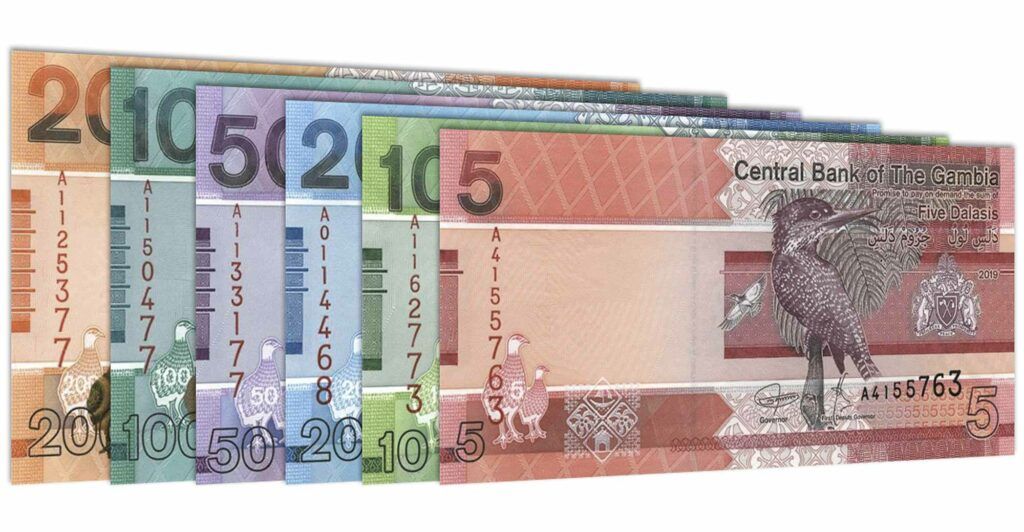As a new year approaches, we’re expanding our horizons – and travel potential – even further with a brand-new currency.
The Gambian Dalasi is the latest addition to our growing list of exchangeable currencies at Leftover Currency. Where will your next adventure take you?
The official currency of Gambia, operating under the currency code GMD, the Gambian Dalasi, was first adopted in 1971.
Before establishing a currency system, Gambia relied on tangible trade instead of money. Locals would trade salt, cloth, shells, and other possessions with value.
This changed in 191,2 with the arrival of British colonialism – introducing Gambia to the modern currency system and making concepts like tourism possible in the country.
We’ve gathered six facts about the Gambian Dalasi – some of which you may be familiar with and others you likely won’t know already.
1. The Gambian Dalasi replaced the Gambian pound
When the British arrived in Gambia in 1912, they brought monetisation with them – setting up the West African Currency Board and introducing the British West African Pound.
When the country became independent in 1965, it could finally create and release its own currency, replacing the pound with the Dalasi.
In the early years of its release, five Dalasi were equal to a single British pound, with one Dalasi equalling 100 Bututs (a smaller denomination, similar to a penny when dealing with British pounds).
2. The Dalasi is known as a floating currency
The Dalasi is a floating currency – just like what we have here in the UK. A floating currency fluctuates according to foreign exchange market rates and activity.
While some are held within a boundary, as depicted by the central banks, others are more fragile, with their currency strength relying on the local economy and its position amid the rest of the world.
Floating currency rates adjust themselves regularly according to the position of one currency amid the world market, with platforms like Leftover Currency checking these rates daily to ensure that we are always offering the internet-leading rate for exchange.
3. “Dalasi” is commonly believed to be derived from “Dollar”
There are a few notable and potential translations for Dalasi and what the term means – however, many believe that it is derived from the word ‘dollar’.
Alongside this, the Butut, a smaller denomination similar to the British penny, directly translates to ‘small thing’.
4. 1 Gambian Dalasi equates to 100 Bututs
To understand any foreign currency, we need to know as much as possible about the breakdown of different denominations. We’ve already covered the value of the Dalasi against the pound upon its initial release, but underneath the Dalasi, we have what’s called the Butut.
A single Gambian Dalasi equates to 100 Bututs – with the 1971 currency release consisting of 1, 5, 10, 25 and 50 Butut coins and a 1 Dalasi coin.
Over time, the number of Butut coins in circulation decreased due to inflation, with the only coins still in circulation being 25 and 50 Butut coins and 1 Dalasi coins (all of the 1998 issue).
5. The highest note equates to 200 Dalasi
Fun fact for you now – since its release in the 1970s, the Dalasi has continued to grow as Gambia’s primary and official currency. Current banknotes range from 5 Dalasis to 200 Dalasi, with reprints featuring new and improved graphics and visual designs and enhanced security.
For example, when the 100 Dalasi notes were issued, they were marked with a silver foil on the front to dictate authenticity.
6. Each new release and reprint has a theme
Finally, for an aesthetic fact – every release and reprint of the Gambian Dalasi banknotes is underpinned by a different theme.
In 2006, cultural references were seen on the front and reverse of each note. In 2015, the release kept the same visuals but added a portrait of President Yahya Jammeh.
In 2019, the latest release was termed the “Birds” and features different native birds on the front of each note paired with cultural references on the back.
Where can you exchange Gambian Dalasi to British pounds?
The Gambian Dalasi is controlled by the Central Bank of the Gambia, with most businesses and locations across Gambia accepting cash instead of other payments.
If you travel to Gambia, you must take some Dalasi with you – opting for an online exchange upon your return through Leftover Currency.
Have you encountered any currencies we don’t offer at Leftover Currency?
Here at Leftover Currency, we proudly offer an extensive and ever-growing selection of currencies for conversion and exchange.
If you encounter a currency we don’t exchange on our site, let us know, and we’ll explore adding it to our growing collection!

 Loading
Loading